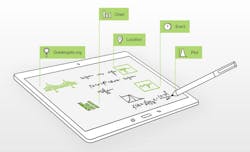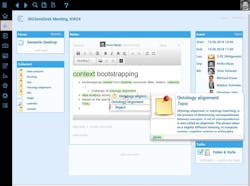AI, Semantic Web Turn Digital Note-Taking into Advancing Knowledge Services
I talked recently with Digital Stationery Consortium’s (DSC) Technology Work Group members about how universal digital-ink-enabled AI with a focus on semantic technology will open up new business opportunities in the emerging digital stationery market. Those interviewed included Markus Weber, Ph.D., Senior Product Manager for WILL (Wacom Ink Layer Language WILL) and Digital Ink, Wacom Europe; and Heiko Maus, Ph.D., Chief Engineer, Head of Topic Area Knowledge Work, German Research Center for Artificial Intelligence (DFKI).
The DSC has been working to establish digital ink as a universal and openly used format. Tell us about the progress you’re making in advancing that mission.
It’s all about unlocking the data in handwritten content and putting it to work. Recently, DSC members Wacom and German Research Center for Artificial Intelligence (DFKI) unveiled a new proof-of-concept (PoC) solution demonstration to advance how AI, especially semantic technologies, can provide knowledge workers with a wider range of digital stationery applications, from note-taking to collaboration services (Fig. 1).
1. By combining research around AI, especially semantic technologies, the new PoC system enables smart services such as note-taking, which requires semantic technology, digital-ink text recognition, and digital-ink graphics recognition to work. (Courtesy of Wacom)
We’ve combined technology and research from Technology Work Group members Wacom and DFKI. Wacom provided WILL and DFKI contributed its evolutionary corporate memory system called “CoMem” to semantically analyze digital handwritten text instantly and contextually to offer smart services (Fig. 2).
2. The evolutionary corporate memory system called “CoMem” supports knowledge work by semantic technologies and offers smart services such as semantic note-taking. (Courtesy of DFKI)
How does the PoC system demonstrate how AI and semantic technologies can take advantage of digital-ink text and graphics recognition to better serve knowledge workers?
The PoC system can semantically analyze digital handwritten writing, note-taking, and drawings instantly, and enable digital-ink-enabled applications, such as note-taking, to understand the context of the information and link to relevant knowledge, and then offer smart services to knowledge workers. For example, it could recognize a handwritten date and suggest using that date to schedule the next meeting with the right collaboration group. Or it could automatically provide online links to all of the related concepts mentioned in the notes.
How does it work?
First, the system identifies the digital-ink data created by each handwritten word, letter, and symbol. Then it interprets whether the data is a date, contact, location, topic, diagram, or another type of concept. Once the system recognizes the context of the digital-ink data, it can then offer the user a wide range of knowledge services (Fig. 3).
3. By semantically analyzing a mixture of digital handwritten writing, note-taking, and drawings instantly, and enabling digital-ink-enabled applications, such as note-taking, to understand the context of the information, the system can link to relevant knowledge and subsequently offer smart services to knowledge workers. (Courtesy of Wacom)
How “smart” is the technology—and why would a knowledge worker want to adopt it?
It’s quite sophisticated. The PoC system helps users build personal knowledge graphs, known as the Personal Information Model (PIMO), which can be extended to teams, groups, or entire organizations. The system can compare handwritten script against existing personal and cross-company knowledge graphs—from terminology to objects (Fig. 4). For the knowledge worker, it makes note-taking easier, quicker, and more intuitive and efficient.
4. A digital-ink-enabled system can compare handwritten script against existing personal and cross-company knowledge graphs—from terminology to objects—and provide further access to knowledge-based services, concepts and online information. (Courtesy of Wacom)
Can you give us some examples of the smart services it could offer?
Sure. Let’s say a meeting participant’s notes include hand-drawn charts or equations. The software includes prompts that offer to turn these into digital graphics. Or what if a note-taker wrote down an address? The system recognizes the location as an address and offers online directions or a map. Names of organizations can generate hyperlinks to company websites. The name of an event could trigger prompts such as adding the dates to the user’s calendar, inviting others to attend, or providing a hyperlink to go online to learn more information.
Even topics can be recognized. Personal topics, contacts, projects, processes, and concepts within a user’s notes can be semantically interlinked and embedded in personal as well as enterprise knowledge graphs. Users are able to glance at the description provided, choose to open the link to browse more in-depth information, or decide to view the information later within the knowledge graph. Moreover, because of the semantic annotation of the text, the notes can be easily found via semantic search, allowing for the use of more abstract concepts such as “notes from conferences mentioning Japanese companies.”
Demo examples you can view and interact with are available at https://will3-semantic-demo.wacom.com/. Also, check out this video, which provides an overview:
How do you see the capabilities evolving in the future?
Our DSC members—not only Wacom and DFKI, but also E Ink, Fujitsu Client Computing Limited, IFlytek, Lamy, Montblanc, Ratta, Samsung, and others—are continuing to seek out new ways to further enhance WILL’s universal digital-ink technology, and provide real-world benefits to the digital stationery market. These advances include expanding the power and range of fine writing instruments; enabling architects, artists, and designers to express themselves more fully; enhancing learning for students; and as the PoC system demonstrates, empowering the knowledge worker. We invite anyone interested in how AI and semantic technology advances are driving new digital stationery applications and services to connect with the DSC membership team.
About the Author
William G. Wong
Senior Content Director - Electronic Design and Microwaves & RF
I am Editor of Electronic Design focusing on embedded, software, and systems. As Senior Content Director, I also manage Microwaves & RF and I work with a great team of editors to provide engineers, programmers, developers and technical managers with interesting and useful articles and videos on a regular basis. Check out our free newsletters to see the latest content.
You can send press releases for new products for possible coverage on the website. I am also interested in receiving contributed articles for publishing on our website. Use our template and send to me along with a signed release form.
Check out my blog, AltEmbedded on Electronic Design, as well as his latest articles on this site that are listed below.
You can visit my social media via these links:
- AltEmbedded on Electronic Design
- Bill Wong on Facebook
- @AltEmbedded on Twitter
- Bill Wong on LinkedIn
I earned a Bachelor of Electrical Engineering at the Georgia Institute of Technology and a Masters in Computer Science from Rutgers University. I still do a bit of programming using everything from C and C++ to Rust and Ada/SPARK. I do a bit of PHP programming for Drupal websites. I have posted a few Drupal modules.
I still get a hand on software and electronic hardware. Some of this can be found on our Kit Close-Up video series. You can also see me on many of our TechXchange Talk videos. I am interested in a range of projects from robotics to artificial intelligence.






